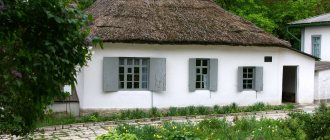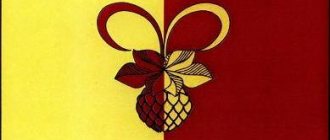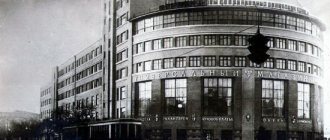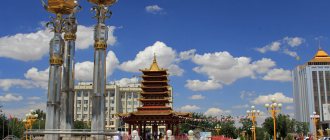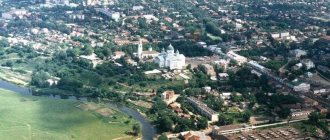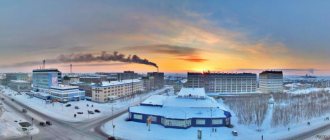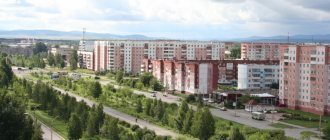The Stavropol Territory belongs to the center of the Caucasus, its borders pass through the Krasnodar Territory, Rostov Region, Kalmykia, Dagestan, North Ossetia, as well as through the Chechen and Karachay-Cherkess Republics.
This territory is famous for its natural attractions: beautiful valleys, clean rivers, mountain ranges, and healing springs. Everyone knows the healing properties of Caucasian mineral waters and mud from the sources of Lake Tambukan. The undoubted pearl of the region is the city of Kislovodsk and Essentuki; it is from the springs located in this territory that Narzan and Essentuki water, known for its healing effect, is produced.
At the foot of the Caucasus Mountains are the centers of the ski resort, which attracts tourists from all over the world. And the snow cap of Elbrus has turned into the calling card of avid climbers.
In this area you can not only relax, but also conduct scientific research, since the region is rich in plant flora and animal fauna. This area is convenient for relaxing, hunting, and fishing.
Edge Features
The climatic conditions of the area are favorable, spring begins in March and lasts until the end of May, the average temperature during this period is +15 degrees and frequent rains are observed. Summers are warm and dry, there is little precipitation, and temperatures can reach +40 degrees, but given that the region has a large number of forests, plantings, lakes and rivers, this is not greatly felt.
Autumn begins in September-October and is characterized by heavy rains, but in November the first snow falls. Winter is not stable, temperatures can fluctuate from +15 to -25 degrees.
The nature of Stavropol is rich in mountain peaks (Strizhament, Nedremanna, Beshtau, Mashuka), steppe and semi-deserts (in the northeast), as well as meadows, forest-steppes and deciduous forests.
In the semi-deserts grow black and white wormwood, ephedra, wheatgrass, prickly thistles, in spring the area comes alive everywhere, tulips, soft lilac crocuses and hyacinths are visible.
The eastern part of the region is characterized by the presence of wormwood-grass and wormwood-fescue dry steppes.
The west and north-west gives way to semi-desert for fertile lands with plowed and untouched steppes and plantings of rural gardens. Common herbs here include: feather grass, fescue, strawberry, meadowsweet, forget-me-not, yarrow, purple-red peony, and many shrubs.
Forests in the Stavropol Territory are located on the Vorovskolessky and Darinsky heights, in the mountains of Pyatigorye, on the Dzhinalsky ridge, in valleys and gullies in the southwest, in the areas of the Kuban, Kuma, and Kura rivers. These are mainly broad-leaved and oak-hornbeam, fir, maple forests, as well as beech, ash and linden.
The largest rivers are Kuban, Terek, Kuma, Kalaus and Egorlyk; in addition to them, there are about 40 small and large lakes.
Chaliapin's dacha
Not far from the railway station in Kislovodsk there is a mansion with turrets, a balcony, stained glass windows, and a ridge on the roof. It houses the literary and musical museum “Chaliapin’s Dacha”.
At the beginning of the 20th century, the house belonged to the merchant Ushakov, who rented it out to vacationers.
Chaliapin's dacha
The singer once rented this house for a vacation, and it was so memorable that the museum was named after him. The museum's exhibitions contain Chaliapin's personal belongings and family heirlooms donated by Chaliapin's daughter. The Chaliapin Seasons are held here annually.
Animals
The fauna of the region includes more than 400 different species, these include predators, herbivores, artiodactyls, and insectivores.
Boar
Wild boars are formidable inhabitants of the forest; they are large in size and have large tusks; they are hunted.
Brown bear
Brown bears are listed in the Red Book. This is a very strong animal with a powerful body and thick hair, its lifespan is 35 years, and its weight is about 100 kg in the spring, before winter the weight increases by 20%. They prefer to live in dense forests and swampy areas.
Jerboa
The jerboa is found in forest-steppe and semi-desert, very fast animals, their speed can reach 5 km per hour, they move on their hind legs.
Komsomolskoye Lake
Due to its small size, local residents often call an artificial reservoir in the city limits of the capital of the Stavropol Territory not a lake, but a pond. There is also a popular name “Komsak”. A reservoir with a two-hundred-year history was formed by blocking the Tashly River to create reserves of scarce fresh water in the provincial center.
After cleaning and updating the water (2020), the reservoir is used not only for urban water supply. Stavropol uses Komsomolskoye Lake as its main resort area. The main advantages of Komsomolsky Pond:
- surrounded on three sides by the Taman forest;
- free sandy beach;
- beach infrastructure (locker rooms, toilets, children's playground, restaurant, sports grounds);
- wooden piers;
- entertainment (children's attractions, catamaran rental, water skiing, scooters).
In August, the “Green Light” festival is held in the lake area, the program of which includes fitness exercises, search quests, an art bazaar, performances by wakeboarders, and dance floors.
Stavropol fishermen catch crucian carp, carp, and silver carp in an artificial reservoir.
But such an activity threatens to deplete fish stocks, since the lake water area has not been stocked with fish for a long time. The administration of the Stavropol Territory is also fighting poachers who catch fish with nets.
How to get to Komsomolskoye Lake
The lake is located in microdistrict No. 13 of Stavropol. You can get to the beach area along Kavaleriyskaya Street. The stops closest to the beach are “House of Trade Unions” (bus 32A, minibus 32), “School No. 5” (minibus No. 30), and “Dachnaya” (minibuses No. 9d, 30, 59).
What to see nearby
In the Tamansky forest, which surrounds the reservoir, you can walk along the “Path of Health” to the Mikhailovsky, Osetinsky, and Cold springs. Walking up Kavaleriyskaya Street, you will see the following sights of the regional capital:
- Assumption and St. Andrew's Cathedrals;
- Baiger's pharmacy;
- railway station building;
- Alexandrovskaya Square.
Animals of steppes and semi-deserts
In the steppe and semi-desert there are:
Saiga antelope
The saiga antelope (saiga) is on the verge of extinction; this artiodactyl animal prefers to settle in the steppes and semi-deserts. The mammal is not large in size with a trunk-shaped nose and rounded ears. Horns are found only on males, who are much larger than the female.
Sand corsac fox
The sand corsac fox belongs to the Canidae family; it is smaller than an ordinary fox and has a short sharp muzzle, large ears and long limbs, a height of 30 cm, and a weight of up to 6 kg. Prefers steppe and semi-desert.
The sand badger lives in dry areas not far from water bodies and is nocturnal. Omnivorous.
long eared hedgehog
The long-eared hedgehog, a representative of this species, is small in number; they look like an ordinary hedgehog, only with very large ears, and are nocturnal.
Midday Gerbil
The crested and midday gerbil belongs to the species of Rodents and has golden-red (midday) and brownish-gray (combed) colors.
Back in the days of the Soviet Union, the following animal species were acclimatized:
Nutria
Nutria is a rodent, reaching a length of up to 60 cm and a weight of up to 12 kg, with the largest weight in males. It has thick fur and a hairless tail, which acts as a rudder when swimming. The animal settles near bodies of water, does not like the cold, but is able to withstand frosts of -35 degrees.
Raccoon dog
The raccoon dog is an omnivorous predator of the Canidae family. The animal looks like a cross between a raccoon (color) and a fox (structure), lives in burrows.
Altai squirrel
The Altai squirrel is much larger than an ordinary squirrel and has a black-brown, bright black color with a blue tint. In winter, the fur lightens and acquires a silver-gray tone. Lives in coniferous deciduous forests.
Altai marmot
The Altai marmot has long wool of a sandy-yellow color with an admixture of black or black-brown, and can reach 9 kg.
Dappled deer
Sika deer, in summer it has a red-red color with white spots, in winter the color fades. Lives in the wild for no more than 14 years. The animal lives in deciduous forests and prefers oak plantations.
Roe
The roe deer belongs to the genus Deer; it is dark red in color in summer and gray-brown in winter. Refers to permitted hunting objects.
In the Stavropol Territory there are extensive hunting grounds where you can hunt wild boars, muskrats, and pheasants. It is possible to purchase a hunting license for waterfowl, wolf, fox, marten, hare and gopher.
History of Stavropol. Stavropol (city history)
Stavropol
Stavropol is one of the largest cities in the North Caucasus region. Before its current name, Stavropol changed its name twice: until 1935 it was called Stavropol-Caucasian, from 1935 to 1943 it was called Voroshilovsk.
Stavropol is a regional administrative center with a multinational population of about half a million people.
In the annual competition of cities “The most comfortable city in Russia”, in 2013 and 2015 Stavropol was recognized as the winner.
The city has an advantageous geographical location with a developed transport network, two international airports, and the tourism sector and health resort treatment continue to expand.
Description of Stavropol
Stavropol is located south of Moscow at a distance of 1,450 kilometers. The southern city is called the “Gateway of the Caucasus”. More recently, scientists have noticed one unique feature - the geographical location of Stavropol. The city is located at the same distance from the North Pole and the equator, more precisely, in the very heart of the northern hemisphere.
Stavropol spreads over an area of over 270 square kilometers. The administrative center consists of three districts: Leninsky, Oktyabrsky and Industrial.
The city stands at the intersection of the Caspian and Caucasus federal highways.
The industrial potential of the city consists of industrial enterprises:
- machine-building, produces trailers for heavy-duty vehicles;
- JSC "Optron-Stavropol", manufacturer of semiconductor devices;
- radio, produces radio-electronic equipment for aircraft;
- Stavkhim LLC, household chemicals plant;
- several oil and gas industry enterprises.
Stavropol is a young city, the average age of the population is 35-45 years old, there are many secondary educational institutions, 20 universities, 11 colleges, several institutions of further education.
The administrative center is surrounded by greenery; in addition to the administration, the public organization “Ecological Patrol of Stavropol” is engaged in urban improvement. Residents voluntarily plant trees and bushes and take care of them themselves. The streets of the city are always clean, there are many parks, gardens, playgrounds, and green areas.
City `s history
The founders of the city of Stavropol are considered to be two outstanding figures of Russia: government functionary G.A. Potemkin and commander A.V. Suvorov.
Stavropol was built as a stronghold, an outpost in the North Caucasus.
To strengthen the southern borders of Russia after the Russian-Turkish War, during the period from 1776 to 1780, the Azov-Mozdok fortified line with 10 fortresses was built. Stavropol was considered the seventh fort with a fortress on the top of Yegorlyk on Tashla. Between the fortresses, at a distance of 30-40 kilometers, fortified Cossack outposts were established. The great commander A.V. took part in strengthening the borders and planning the fortresses. Suvorov.
The city appeared thanks to a fortress built on a hill in 1778 and called the Stavropol-Caucasian Fortress. The 1st Khopyor Regiment of the Kuban Cossack Army was based in the bastion. The citadel housed Cossack officers, there were barracks, a gunpowder warehouse and outbuildings.
In 1824, by Decree of Emperor Alexander I, government institutions with local authorities were transferred to the fortress from Georgievsk.
Russian Emperor Nicholas I personally visited Stavropol in 1837.
In 1847, the Caucasus region, consisting of 6 counties, was renamed the Stavropol province.
From 1897 to 1916, the Tuapse-Elista railway line was built through Stavropol.
New time
In 1918, the entire territory of the Stavropol province, with the advent of Soviet power, became part of Soviet Russia, and the city of Stavropol was declared the capital. In the same year, in December, Stavropol became the administrative capital of the North Caucasus Republic.
During the civil war, from the autumn of 1918 to February 1920, the city periodically came under the control of the Red troops or the White Volunteer Army. At the end of February 1920, Stavropol was occupied by units of the Red Army.
During the Great Patriotic War, the city was occupied from August 1942 to January 21, 1943. The plans of the Hitlerite leadership included the creation of the Caucasus Reich Commissariat on Stavropol soil, a national education with the establishment of a “new order”. This remains a bloody page in the history of Varoshilovsk. During the occupation, the city not only lost its natural and industrial resources, more than 40 thousand people were forcibly taken to work in Germany.
After the war, the restoration of the city began. The 60-80s of the last century were at the peak of the development of industry and housing construction.
Now the city is thriving, there are many architectural monuments, stadiums and football fields, indoor ice arenas, three theaters, 10 cinemas, the famous Cossack song and dance ensemble “Free Steppe”.
Stavropol was visited by Russian classics: Pushkin, Lermontov, Tolstoy, Belinsky.
Rare animals
Caucasian jungle cat
The Caucasian jungle cat is a medium-sized animal with long paws and a short tail. Only a few individuals remain alive.
Caucasian forest cat
The Caucasian forest cat belongs to the Felidae family and is very similar to a domestic cat, only with a larger size. The color of the animal is gray-red with a yellow tint, with clear stripes on the back and sides.
Steppe ferret
The steppe polecat is on the verge of extinction due to the shrinking of the steppe zone and trapping for its valuable fur.
The Gadaur snow vole resembles a hamster in its appearance; it prefers housing in rocky areas or in bushes; it is listed in the Red Book.
To prevent the extinction of some species of animals and birds, 16 state reserves have been organized in this area. In addition to the species presented, mink, several species of bats, hamsters, and mole rats are also protected.
Mink
Hamster
Mole rat
Lermontov
Lermontov is a small resort village, which is located in the south of the Stavropol Upland and today is the center of the Caucasian Mineral Waters.
The city of Lermontov (Stavropol Territory) was founded in 1953. Initially, it was an ordinary working village for poor residents. The population is about 25,000 people. The name of the city is associated with the name of the great poet M. Yu. Lermontov. The city rightfully bears the title of one of the youngest settlements, which are currently very actively developing thanks to tourists. Walking around the area, you can see a huge number of archaeological and historical monuments of ancient and middle eras. The city offers vacationers the presence of all kinds of entertainment, health and other complexes. For a more extreme and educational holiday, a variety of hiking trips and trips to the ski slopes are offered. Also in the city there are a large number of hotels, small hotels, boarding houses and sanatoriums, rooms are rented in private sectors, so everyone can find a suitable place for a great holiday.
Amphibians and reptiles
Let's consider small numbers of individuals that are protected; their catching is prohibited.
Caucasian toad
The Caucasian toad is the largest amphibian in Russia; the female’s body length can reach 13 cm.
Asia Minor frog
The Asia Minor frog is a rare species of animal.
Newt Lanza
The Lanza newt lives in coniferous, deciduous and mixed forests.
The reptiles include lizards, snakes, sand boas, snakes and vipers, which are listed in the Red Book.
Birds
The most common birds you encounter are:
Bustard
The bustard is a large bird, found in the steppe, belongs to the order Crane-like animals, reaches a size of up to 16 kg (male) and has a variegated color (red, black, gray, white).
Little Bustard
The little bustard does not exceed the size of an ordinary chicken and resembles a partridge. The upper part of the body is sandy in color with a dark pattern, and the lower part is white.
Demoiselle crane
The demoiselle crane is the smallest representative of the Cranes, its height is 89 cm and its weight is up to 3 kg. The head and neck are black, there are areas of light gray feathers in the area of the beak and eyes, the beak is short and yellowish.
Large feathered predators include:
Imperial Eagle
The Imperial Eagle is one of the largest avian species, with a body length of up to 80 cm, a wingspan of up to 215 cm, and a weight of about 4.5 kg. Females are much larger than males. The color is dark brown, almost black with snow-white spots on the wings and a brown-gray tail.
Buzzard Eagle
The Buzzard eagle, unlike the eagle, has a reddish plumage; they adhere to the steppe, forest-steppe and desert.
They prefer to settle in the mountains:
Caucasian snowcock
The mountain turkey is a relative of the pheasant and is similar to a cross between a domestic chicken and a partridge.
Caucasian black grouse
The Caucasian black grouse is listed in the Red Book. The bird is black in color with blue areas, white feathering on the tail and wings, and red eyebrows.
Bearded Eagle
The bearded eagle is a scavenger vulture, with plumage on the head and neck, sharp wings and a wedge-shaped tail.
Griffon Vulture
The griffon vulture belongs to the hawk family and is a scavenger.
In total, more than 400 species of birds live in forests, mountains and plains.
